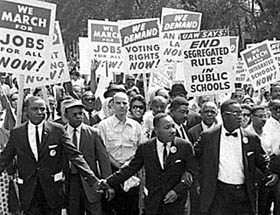 |
Since Martin Luther King Jr.'s assassination in 1968, his murder has become endless fodder for conspiracy theorists. Complete with shadowy film noir atmospherics and sensational charges leveled at the highest circles of power, the King conspiracy theories rival the most crazed accounts of Kennedy's assassination.
These theories gained renewed momentum when King's son Dexter met with his father's convicted assassin in prison in 1997. With the blessings of King's widow and the other King children, Dexter King shook James Earl Ray's hand and professed belief in his innocence. A second boost to the legitimacy of the King conspiracy theories came the following year when Attorney General Janet Reno reopened a limited investigation into the assassination in August 1998. And finally, in Dec. 1999, a Memphis jury awarded the King family $100 in a wrongful death suit. The jury professed that the murder was indeed a conspiracy involving bar owner Lloyd Jowers (see conspiracy theory #4 below) and several "unknown" co-conspirators. Few journalists, scholars, or law enforcement officials familiar with the case have given credence to the new court findings.
In the accepted version of the assassination one which no credible historian, federal or state investigation, or court of law has disputed James Earl Ray, a career criminal and racist, murdered Martin Luther King on April 4, 1968. An escaped convict, Ray rented a room in Memphis across from the Lorraine Motel where King was staying while mediating a sanitation workers' strike. Using a rifle with a sniper scope, he shot King from his bathroom window as King stood on the balcony of the motel. The single bullet severed King's spinal cord and killed him.
| To escape facing the possibility of execution, Ray pleaded guilty in March 1969. A trial was waived and he was given a 99-year prison sentence. |
Witnesses reported seeing Ray fleeing his rooming house moments later. Ray's fingerprints were found on a pair of binoculars and the rifle, which records show he had purchased six days before the shooting. Following a two-month-long manhunt, Ray was arrested at Heathrow Airport after he had robbed a London bank. As he told his first attorney, Percy Foreman, "I thought I could get to [South] Africa and serve two or three years in one of them mercenary armies and those folks over there wouldn't send me back."
To escape facing the possibility of execution, Ray pleaded guilty in March 1969. As a result, a trial was waived and Ray was given a 99-year prison sentence. Even though he had told the judge he understood that a guilty plea could not be appealed, he recanted his confession three days later. Despite many appeals, none of Ray's numerous lawyers ever produced evidence to convince a court of law to reopen the case. A federal investigation in 1977-1978 by the House Select Committee on Assassinations concluded that although "there is a likelihood" that Ray did not act alone in planning the assassination, he alone pulled the trigger.
Until he died in prison on April 23, 1998, Ray maintained his innocence, spinning a series of outlandish, often contradictory conspiracy theories, beginning with the reason he initially confessed to the murder: Ray claimed it was coerced by his lawyer, who was angling for a lucrative movie deal. The most widely circulated theories follow.
Conspiracy Theory #1:
Ray was the unwitting patsy of Raul, a mysterious underworld figure
 Was Ray, a career criminal and known racist, nothing more than a patsy for someone even shadier? |
Ray claimed he was framed by a shady character named Raul, with whom he was involved in smuggling operations, though Ray said he never learned Raul's last name, or even what it was he was smuggling. When Raul told him to buy a rifle and check into a certain rooming house in Memphis, Ray simply did so, no questions asked.
There Ray handed the rifle over to Raul, never to see him again. In another version Ray claims he waited in the car, and then heard a shot, after which Raul ran out and jumped into the car.
No Raul ever materialized, until conspiracy investigators rounded one up, in 1994 accusing a retired auto worker from upstate New York, whom Ray claimed to recognize from a photo.
The man was easily cleared of any involvement, but has been unable to escape the stain of notoriety: "They have turned my life upside down... When Dexter King said that I had been found, my wife and I were shocked. This will never end for me, I fear... Doesn't the truth matter anymore in this country?"
Conspiracy Theory #2:
It was the government, the Memphis police, the FBI, and Army intelligence not to mention the Mafia and the Green Berets
William Pepper, Ray's last lawyer, claims that Ray was set up by the U.S. government, who had hired a Mafia hit man to kill King. A team of Green Beret snipers lurked nearby as back up, should the Mafia hit man miss. But the plot by no means stops here: the CIA, the Memphis police, the FBI, and Army intelligence were also involved. As Pepper spells out in his 1995 book, Orders to Kill: The Truth Behind the Murder of Martin Luther King, the commando in charge of the Green Beret snipers, Billy Eidson, was then killed off to keep the plot secret.
Not only was a military cablegram Pepper produced declared a forgery, but Green Beret Billy Eidson was found to be alive and well and furious at the allegations that he was involved in the assassination. Also not amused was the 20th Special Forces Group of Alabama, the accused Green Berets. But that didn't stop the paperback version of Pepper's book from being published in fact, it fortuitously hit the stores the same month that Ray died, no doubt capitalizing on the added publicity.
As astoundingly reckless as Pepper's allegations are, he has convinced the King family of their veracity. On an edition of ABC's Turning Point, June 19, 1997 the same segment that systematically disproved the key elements of Pepper's story Coretta Scott King and several of the King children announced their belief in Ray's innocence and the existence of a government plot.
Dexter King maintained that "Army intelligence, CIA, FBI" were responsible for his father's death, and when asked by commentator Forest Sawyer whether he believed Lyndon Johnson was part of a plot to kill [his] father," he responded, "I do."
Conspiracy Theory #3:
Raul Resurrected proof uncovered in FBI man's refrigerator
In 1998, Donald Wilson, a retired FBI employee, said he found pieces of paper in Ray's car after the shooting that had the name "Raul" written on them. He took this evidence home and stored it in his refrigerator for most of the next thirty years. The FBI claims Wilson was not part of the search team and that his evidence is "total fabrication."
Conspiracy Theory #4:
The Bar Man did it
Memphis bar owner Lloyd Jowers, who in 1968 ran Jim's Grill, located across the street from the Lorraine Motel, claimed in 1993 that a Memphis produce dealer, Frank Liberto (now dead), gave him $100,000 to hire a hit man to murder King — and the killer he hired wasn't Ray.
After a 7-month investigation, Memphis District Attorney General Bill Gibbons reported that he could find no evidence Jowers had any involvement in the murder. ABC's Primetime Live broke Jowers's story in 1993; in 1998 the same show denounced Jowers as a fraud.
A New Investigation
| A career criminal, Ray pulled off many successful crimes and engineered two prison escapes — hardly the signs of a dull-witted hick. His racism was brutal — he was quoted as saying: "We ought to kill them black people, kill them all." |
The current investigation by the Justice Department centers on the latter two theories, the allegations brought forth by Donald Wilson and Lloyd Jowers. The review will be conducted under the leadership of Barry Kowalski, who successfully prosecuted the Los Angeles police officers who beat Rodney King. Perhaps the investigation will stem the circulation of preposterous conspiracy theories, or at the very least put an end to the fiction that Ray was an innocent pawn.
A career criminal, Ray pulled off many successful crimes and engineered two prison escapes —hardly the signs of a dull-witted hick. His racism was brutal —a friend quoted him as saying: "We ought to kill them [black people], kill them all."
When offered a transfer to a prison farm, he declined because the dormitories were racially integrated. When he was arrested for King's murder, he was on his way to South Africa, then under apartheid, hoping to become a mercenary.
As NAACP President Julian Bond commented a few years ago, "the problem is, we have trouble believing that a no-account, stumbled-down bum of a convict like Ray could kill such a remarkable person like King. But he did."
For an authoritative exploration of the King assassination, see Killing the Dream: James Earl Ray and the Assassination of Martin Luther King, Jr., by Gerald Posner.For the views of James Earl Ray's attorney, see Orders to Kill: The Truth behind the Murder of Martin Luther King, Jr., by William F. Pepper.






